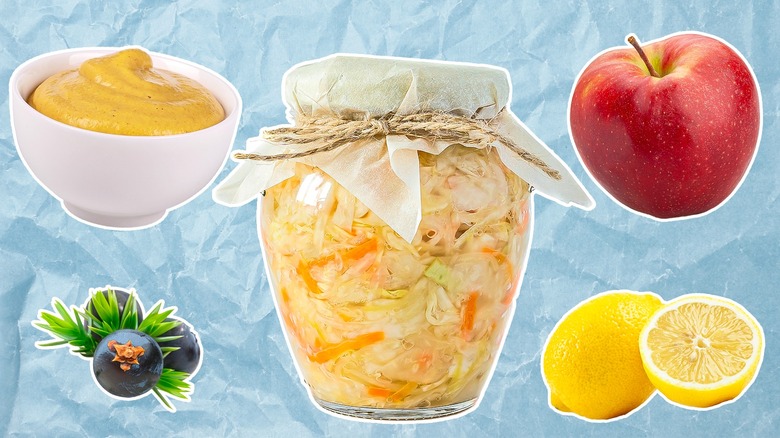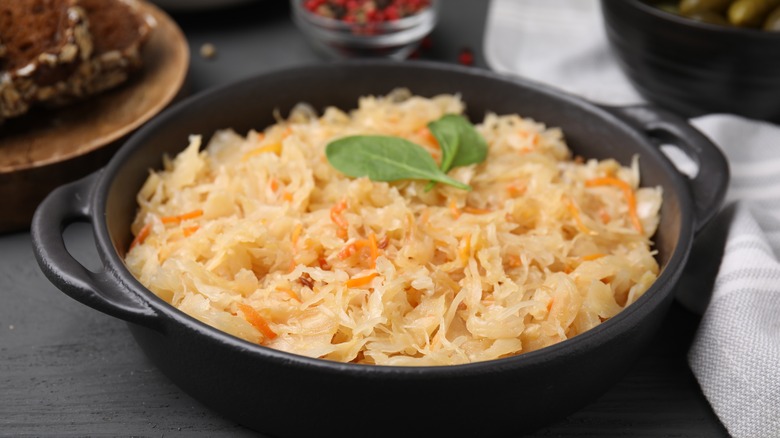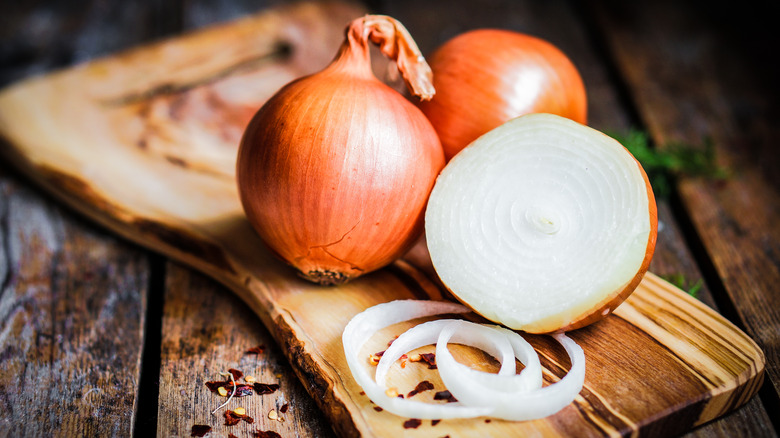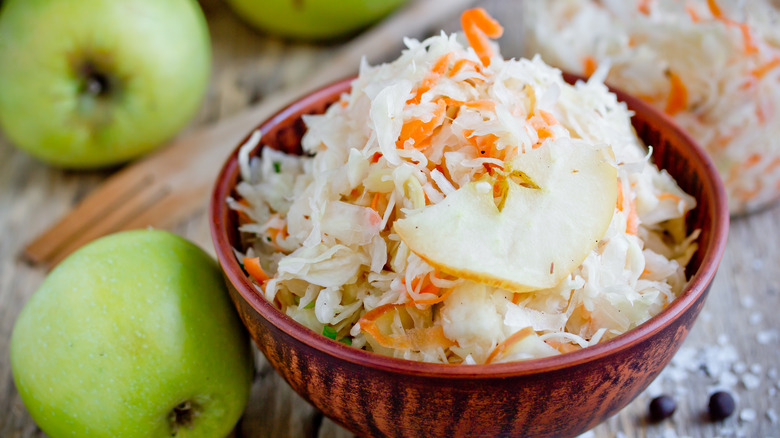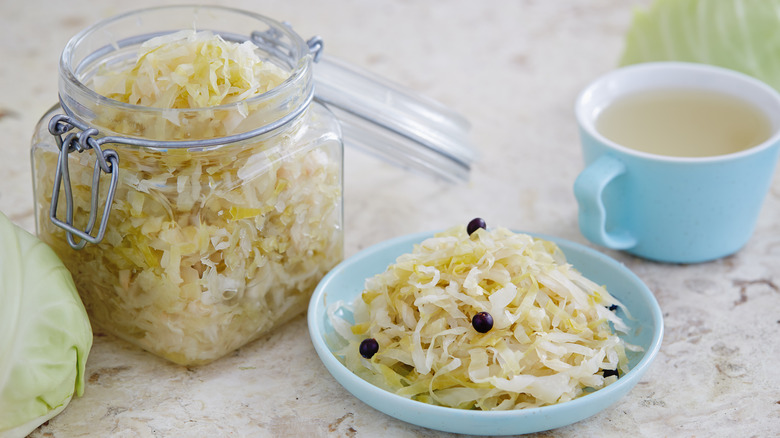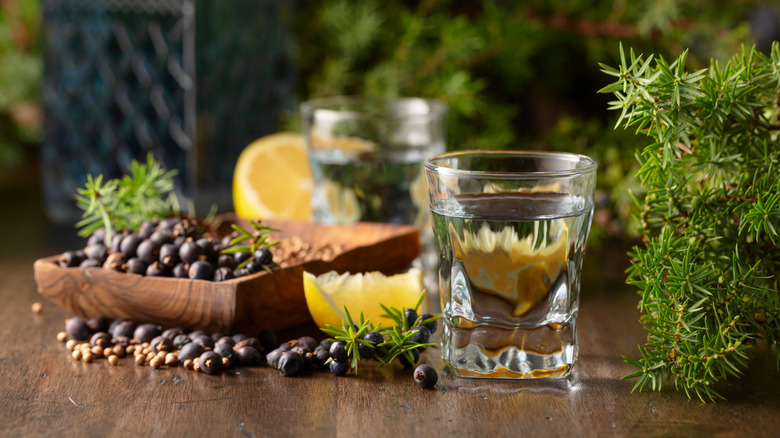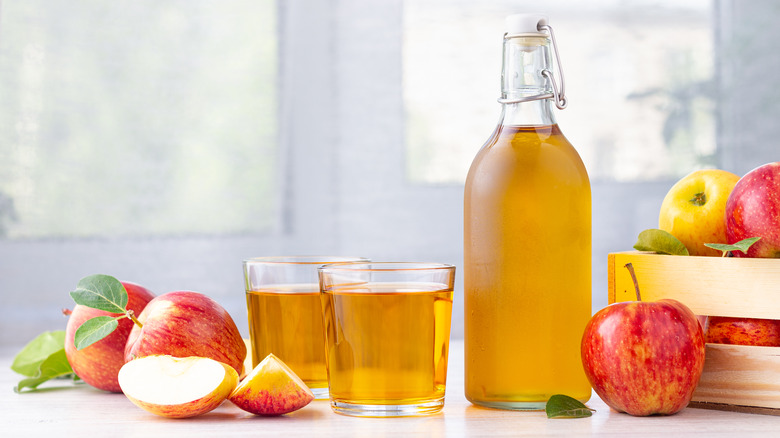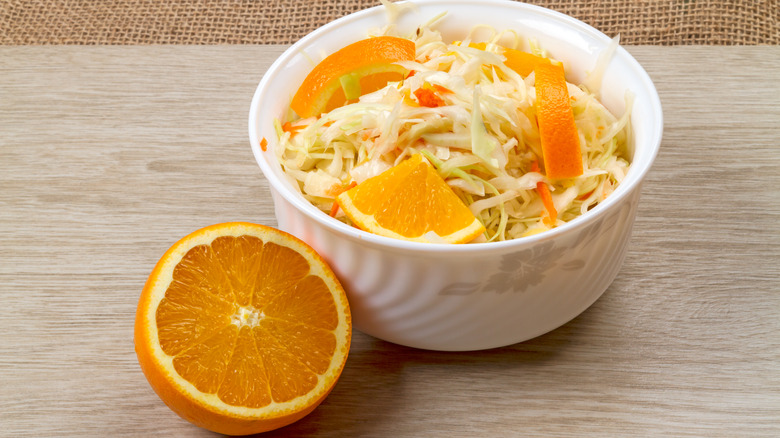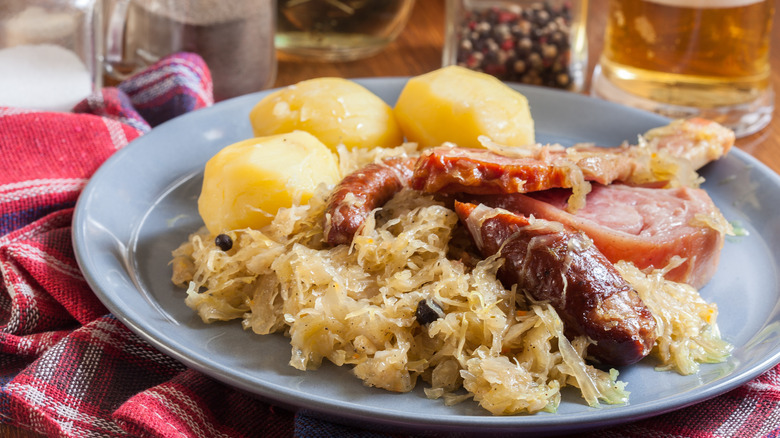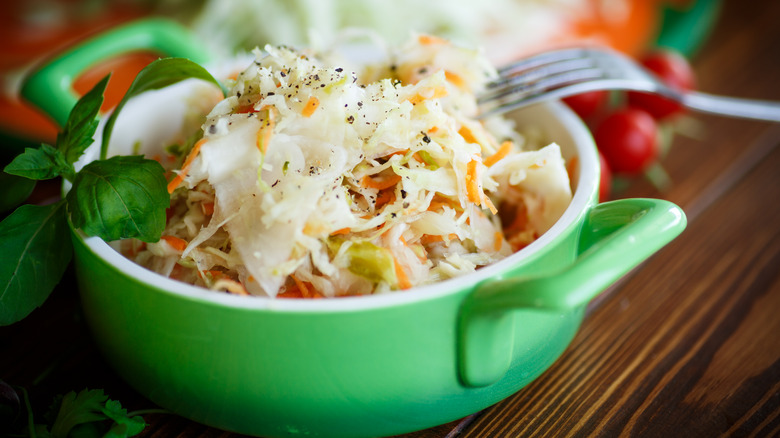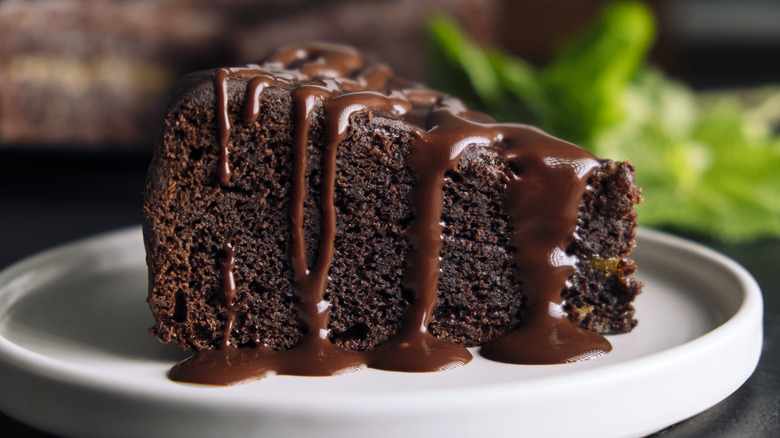15 Ways To Make Canned Sauerkraut Taste Better
Fermented foods are having a moment with enthusiasts plunging into the intricacies of fermented versus pickled foods and exchanging dinner table chit-chat about probiotics and the microbiome. Sauerkraut has benefited from that renewed interest, and in fact, you should start eating more sauerkraut for its potential nutritional benefits.
Fermenting sauerkraut at home is the ideal way to do that, but many of us aren't keen on having crocks of fermenting cabbage taking up realty space. Fresh-fermented sauerkraut from an artisanal vendor is just as good, but as a community of living organisms, it can quickly spoil if not stored properly.
That leaves us with canned sauerkraut. There's a noticeable difference between raw sauerkraut and canned, partly because canning kills the probiotics and partly because its flavor is a bit subdued. So how do you dial canned sauerkraut up a notch? Well, start with the best-canned sauerkraut you can find, and then work your way through these tips.
1. Give your canned sauerkraut a bath
Rinsing canned sauerkraut is optional, but the brine in most brands adds a lot of sodium to what's already a salt-heavy side dish. Unfortunately, draining away the brine also takes away some of the flavor. That's especially important if you plan to eat the sauerkraut straight from the can, as is.
To freshen it up without losing any flavor — better yet, while adding flavor — drain the can and then top it up with an inexpensive dry white wine instead. Draining the brine reduces the sauerkraut's salt level, while the white wine gives it a fermented flavor that's missing from canned sauerkraut.
If you're going to simmer the kraut, you can use it immediately, though we find it's better after 30 to 60 minutes in the wine bath — several hours or overnight are also fine. If you're not a wine lover, apple cider, beer, or even apple juice will work well. Whichever beverage you choose, it'll improve the canned sauerkraut on your Reuben sandwich or knackwurst.
2. Add some richness with fat
Sauerkraut's acidity is what makes it such a perfect complement to rich, fatty meats such as pork and goose. That refreshing tang keeps the meats' richness from overwhelming your palate and helps balance the flavors on your plate.
Of course, that works both ways. Whether you're quickly sautéing canned sauerkraut to top a couple of hot dogs or slow-cooking the ingredient for a full meal, it will benefit from the addition of some fat. The richness of the fat mellows the sharpness of the sauerkraut and makes the dish more satisfying. If butter is the secret ingredient that takes your tomato pasta sauce to the next level, then you already understand the principle.
For quick cooking in a skillet, add a pat of butter or bacon fat or even duck fat if you have some stashed away. In soups, stews, or braised canned sauerkraut, you can start the dish this way before adding your liquids. However, skip this step in recipes that already contain lots of meats because they'll give you the necessary fat.
3. Sauerkraut can use some onions
Some things just belong together. Classic pairings like milk and cookies, strawberries and cream, or gin and tonic have all stood the test of time because they just work. Onions and sauerkraut are that kind of pairing.
Onions add sweetness and a savory note to sauerkraut's sometimes sharp punch, which is why they're often paired together, like in this kielbasa and sauerkraut skillet recipe. Now, don't go out and spend big on specialty onions because plain old white or yellow varieties would do the trick.
A few minutes together in a skillet is long enough for the two ingredients' flavors to infuse and enrich each other, and that's all you'll need for topping bratwursts or other sausages. In slower-cooked meals, the onion and sauerkraut flavors will blend completely, getting lost in each other like the couples in a Hallmark movie — in a good way, obviously.
4. Sweeten canned sauerkrauts with apples
Many old-school German and Eastern European recipes — the kind you'll find in vintage church social or community cookbooks across the Midwest — call for apples to be cooked with sauerkraut. The idea of adding another acidic ingredient like apples to canned sauerkraut might seem odd, but it's more common — and appropriate — than you'd think.
Even a tart apple is sweeter than the sharp-tasting sauerkraut, and cooking brings out their sugars. The overall effect of the apple is to sweeten and mellow the sauerkraut in a supporting role without overpowering the sauerkraut's own flavor. In fact, sweet fruit elevates umami flavors in many dishes. Ham and pineapple, anyone? Cranberries with your turkey?
So whether you're cranking out a few sandwiches or filling your slow cooker with pork and sauerkraut, take a moment to add an apple or two to your canned sauerkraut. Use unsweetened applesauce if you're in a pinch.
5. Sprinkle in spices and aromatics
Spices and aromatic vegetables are must-haves in the kitchen because of the flavors they bring to the table, though the trick is learning which flavors work well in the dish you're planning. Tradition is a reliable guide, but there's always room for experimentation.
When we're talking about sauerkraut, the most traditional spices and aromatics come from anise-like caraway seeds, bay leaves, and the distinctive spicily earthy juniper berries. Those are all good options, and a lot of recipes call for them.
If you want to experiment, there are plenty of other ingredients that work with canned sauerkraut, depending on your taste and the dishes you're making. We've personally enjoyed less traditional options, including red pepper flakes, cumin and coriander, fennel, and celery root (celeriac). We've also seen other chefs use smoky ancho chilies or chipotle peppers and finish a dish with a dusting of smoked paprika to replace some of the cured pork smokiness in vegetarian versions of classic dishes.
6. Douse canned sauerkraut with spirits or liqueurs
Juniper berries can be challenging to find, but gin is not, and juniper is the main flavoring in gin. If you keep gin in the house, add a splash to your next meal of sauerkraut and see what you think. No two brands have quite the same recipe, so they'll bring a slightly different flavor profile to your finished dish, but we find that a classic London Dry Gin, like Beefeater or Tanqueray, is a safe choice.
Similarly, if you don't have caraway seeds, you can turn to your drinks at hand. There's a German spirit called Kümmel that's flavored with caraway seeds, which would fit the bill nicely, but it's not your only option; other liqueurs with a similar licorice or anise flavor would work. Bear in mind that spirits vary in strength, sweetness, and secondary flavors — Italian liqueur Sambuca and absinthe are worlds apart, so use them cautiously.
If you really want to spread your wings, open the doors to other liqueurs with strong herbal flavors. The safest way to experiment is with a finished sauerkraut dish; add the liqueurs a few drops at a time so you can judge the effect without being overwhelmed. Less is more.
7. Cook with cider, apple juice, white wine, or beer
As previously mentioned, you can bathe your canned sauerkraut in white wine, beer, apple cider, or apple juice. But aside from bathing, you can cook those liquids with the sauerkraut to ramp up the flavor. Even if you're just quickly frying sauerkraut up with onions as sausage toppings, you can hit the pan with a splash of one of those drinks, which will rapidly become concentrated as it bubbles and evaporates, and the effect is even stronger when you're slow-cooking.
Because apples and sauerkraut are a classic combination, let's start there. Cooking your sauerkraut with apple cider or juice saves you from peeling the fruit but still brings that mellow flavor to your finished dish. White wine is another option that works well with sauerkraut, especially if you're cooking a traditional European dish and choose a wine from that same region.
Beer is another obvious choice; it plays nicely with sauerkraut, as well as sausages or any rich, cured meats in the dish. Cooking with beer holds a few potential pitfalls for the unwary because there are so many different kinds, but this approach will usually work: If your recipe specifies a given beer, use that. Otherwise, taste the beer while keeping in mind how it would pair with the flavors in your dish. We find really bitter, hoppy beers problematic, but most others work fine.
8. Shake in a few drops of your favorite bitters
There are flavoring ingredients you add to your dishes at the very beginning and others that are best added right at the end. That way, their flavors are fresh, bright, and high-impact, rather than dissipating and submerging themselves in the overall dish.
Bitters are one of those ingredients. If you keep them on hand, you probably use bitters in cocktails. They're an essential part of a serious mixologist's arsenal because their complex flavors add depth and nuance to the fruit juices, syrups, and mass-market spirits found in most bars. Those same characteristics serve as the perfect finishing touch in sauerkraut dishes, especially the slow-cooked ones.
Angostura bitters are offered in almost any supermarket, and their delicate notes of clove and cinnamon play well with the apples used in sauerkraut recipes. Similarly, their signature bitterness helps define sweet, tart, and savory components in the other recipe ingredients and keeps them grounded.
There are dozens of other cocktail bitters brands, some more artisanal than others, so if you're a mixology enthusiast, this is your chance to exercise your bitters collection for culinary purposes.
9. Include a twist of citrus
Canned sauerkraut is already tangy, but upon reflection, adding citrus makes sense. Sauerkraut's signature tang is relatively one-dimensional, so any ingredient that can brighten and elevate its flavors has a potential role to play.
Brightening and elevating other flavors is citrus' strength, and citrus zest — either fresh or dried — is a surprisingly influential addition to sauerkraut dishes; orange and lemon zest both bring a fresh, aromatic, almost floral note to the finished meal. We find zest is best added late in the cooking process, as it can become bitter or lose its brightness with lengthy cooking. You can also save it until the very end and use fine zest as a garnish on the finished dish.
Citrus is often added to homemade sauerkraut at the fermenting stage to infuse that bright flavor permanently. Of course, you don't get to do that with canned sauerkraut, but a pro tip is the add-ins you see in homemade sauerkraut recipes usually work for cooking sauerkraut as well.
10. Braise canned sauerkraut
Stewing and braising are classic cooking techniques that call for slow cooking your food in a simmering liquid until they're tender and mellow. It's the ultimate way to upgrade your canned sauerkraut, as only slow cooking can leave it utterly transformed.
It's not complicated. You can slow-cook the sauerkraut in its own brine, augmented with water or broth, or add wine, cider, or beer as you prefer. Once you've filled the pot and found the right temperature, you can just walk away and let it simmer at low heat for hours while you get on with your day. When it's finished, the canned sauerkraut will be silky and mellow, its sharpness rounded, and its flavors enriched by the long cooking time.
This is classic European comfort food, and you'll find variations everywhere from France — with its famous choucroute garnie – all the way through central and eastern Europe. The flavors of each regional dish will vary, depending on local tastes and ingredients, but the process is very much the same.
11. Load sauerkraut up with smoked and cured meats
If there's a recurring theme to sauerkraut recipes, it's probably the affinity for rich, fatty, and cured meats to enrich the sauerkraut. Meanwhile, the sauerkraut's tang helps balance the meats' richness, and it's very much a culinary win-win.
Take a look at what you've got on hand or can easily pick up at your local store: sausages, bacon, hams, smoked ham hocks, smoked pork chops, or just a plain pork shoulder are all great for sauerkraut. Don't overlook less-common options like a smoked turkey leg or duck or goose confit. Confit is more common in classic French cassoulet, another slow-cooked dish, but it's equally at home in your sauerkraut.
It's a bit trickier if you're preparing a sauerkraut dish for vegans or vegetarians, but imitation meats are improving all the time, and we've successfully used plant-based sausage with sauerkraut. Alternatively, experiment with straightforwardly vegan products like smoked or fermented tofu, or as a last resort, liquid smoke or smoked paprika and a dollop of your favorite plant-based cooking fat to provide the necessary richness.
12. Stir in some mustard
If you think about the condiments you've seen alongside sauerkraut over the years, mustard tops the list. It might be plain, yellow, ballpark mustard on sauerkraut-topped hot dogs or a selection of artisanal mustards alongside a choucroute garnie, but mustard is almost invariably there.
Sauerkraut is simply fermented cabbage, after all, and mustard loves vegetables in the Brassica family. It makes perfect sense because mustard itself is a vegetable in the Brassica family: The two species used in most commercial mustards are Brassica juncea and Sinapis alba, and gardeners will recognize them immediately as close kin to kale, broccoli, and tatsoi.
So, instead of using it as a condiment on the side of the finished sauerkraut, stir a spoonful of your favorite mustard into the dish as it cooks. The heat from cooking will mellow the mustard's sharpness and incorporate a depth of flavor into the canned sauerkraut that it wouldn't otherwise have.
13. Turn canned sauerkraut into a salad
If you're not into cooking your sauerkraut, we've got something for you. Though canned sauerkraut lacks the probiotics (and funk) of the freshly fermented kind, it still has a bit of texture and is packed with a tangy flavor, so why not make it into salad?
One quick option is to stir some drained sauerkraut into your favorite coleslaw recipe because when you get right down to it, sauerkraut is a well-marinated slaw. Mixing it with shredded fresh cabbage and dressing dilutes the canned sauerkraut while simultaneously upgrading the slaw with a punch of extra acidity.
For a more conventional option, look for inspiration from Europe's tradition of sauerkraut salads. They're usually built around sweet-tasting vegetables, like carrots and bell peppers, and often crunchy fruits like apples, thinly sliced or shredded and then mixed with the drained sauerkraut. It makes for a really refreshing summertime side dish.
14. Make sauerkraut soups and stews
Some cabbage varieties keep for a while, staying edible in a root cellar for a few months, but fermenting them into sauerkraut is what makes it possible to eat them all winter long. In the centuries before modern refrigeration, fermented cabbage was one of the very few vegetables available during those cold months.
Given those same cold months are the time of the year when we most enjoy hearty soups and stews, it's no surprise that Europe's culinary traditions include a lot of soups and stews based on sauerkraut. You'll see them primarily in Eastern and Central Europe, where they're cherished.
The beloved Polish stew called bigos, also known as hunter's stew, is made of sauerkraut with as many kinds of game and cured meats as you can muster. There are many other soups and stews to choose from, including Latvian štovēti kāposti and Ukrainian kapustnyak, but you don't need to limit yourself to European recipes. Pick a sturdy soup or stew you already like, add in some canned sauerkraut, and let it simmer. You'll be pleasantly surprised at the outcome.
15. Infuse canned sauerkraut into dessert
Baking calls for a lot of acidic ingredients, ranging from tart lemon juice to tangy buttermilk and rich sour cream to sweet molasses. They serve several purposes: They may complement a dominant flavor, add richness and moisture, or even help leaven the baked goods by interacting with baking soda to create bubbles.
Despite knowing all that, the thought of putting sauerkraut into dessert may feel strange. Still, hear us out: You've probably already used moist shredded vegetables in your baking, like carrots in carrot cake or zucchini in zucchini bread. Sauerkraut ticks all of the boxes: It's a shredded vegetable that adds acidity. Remember, a lot of bakers already use unlikely ingredients, such as mayonnaise or tomato soup, in their cakes, so it's not as weird as it sounds.
However, you can't just take it out of the can and plunk it into your mixing bowl, of course. You'll need to rinse and drain it and then chop it finely by hand or in your food processor. Not sure which baked treat to attempt this with? Well, sauerkraut is the ingredient that will change your chocolate cake forever; it matches well with the star of the show because chocolate is such a strong flavor in its own right. Cakes aren't your only option, either. A quick online search will lead you to other sauerkraut sweets, from candies to pies to donuts.
